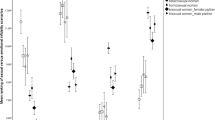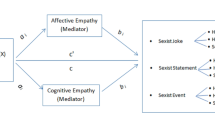Abstract
This work tests two conflicting views about double standards: whether they reflect evolved sex differences in behavior or a manipulative morality serving male interests. Two questionnaires on jealous reactions to mild (flirting) and serious (cheating) sexual transgressions were randomly assigned to 172 young women and men. One questionnaire assessed standards for appropriate behavior and perceptions of how young women and men usually react. The second asked people to report how they had reacted or, if naive, how they would react. The questions concerned anger at and blame of partner and rival and the self-oriented responses of loss of self-esteem, feelings of hurt, and fear of losing the partner. As predicted by the idea of manipulative morality, both sexes advanced sets of double standards that serve the interests of their own sex at the expense of the opposite sex. Much of the data contradict the idea of a match between double standards and evolved sex differences. First, subjects who set self-serving double standards did not perceive gender differences in jealous reactions. Second, there were few gender differences in judgments regarding jealous responses. Third, in contrast with the familiar double standard, women were more aggressively reactive to a flirting rival than men. Fourth, self-reports of the strength of aggressive jealous reactions suggest that women’s behavior is stronger than the prescriptions for it. These data suggest that double standards represent a communication strategy which assists men’s control of women. The data on jealous reactions were interpreted in terms of the degree of threat to fitness posed by infidelity in different situations.
Similar content being viewed by others
References
Alcock, J. 1989Animal Behavior, fourth ed. Sunderland, Massachusetts: Sinauer.
Alexander, R. D. 1987The Biology of Moral Systems. Hawthorne, New York: Aldine de Gruyter.
Baenninger, M. A., R. Baenninger, and D. Houle 1994 Attractiveness, Attentiveness, and Perceived Male Shortage: Their Influence on Perceptions of Other Females.Ethology and Sociobiology 14:293–304.
Bateman, A. J. 1948 Intra-sexual Selection inDrosophila.Heredity 2:349–368.
Betzig, L. 1992a Roman Monogamy.Ethology and Sociobiology 13:351–383.
1992b Roman Polygyny.Ethology and Sociobiology 13:309–349.
Biernat, M., M. Manis, and N. E. Nelson 1991 Stereotypes and Standards of Judgment.Journal of Personality and Social Psychology 60:485–499.
Bischof, N. 1975 Comparative Ethology of Incest Avoidance. InBiosocial Anthropology, R. Fox, ed. Pp. 37–67. London: Malaby.
Breuer, G. 1982Sociobiology and the Human Dimension. Cambridge: Cambridge University Press.
Bryson, J. B. 1991 Modes of Response to Jealousy-Evoking Situations. InThe Psychology of Jealousy and Envy, P. Salovey, ed. Pp. 178–210. New York: Guilford.
Buss, D. M., and D. P. Schmitt 1993 Sexual Strategies Theory: An Evolutionary Perspective on Human Mating.Psychological Review 100:204–232.
Buss, D. M., R. J. Larsen, D. Westen, and J. Semmelroth 1992 Sex Differences in Jealousy: Evolution, Physiology, and Psychology.Psychological Science 3:251–255.
Buunk, B. P. 1991 Jealousy in Close Relationships: An Exchange-Theoretical Perspective. InThe Psychology of Jealousy and Envy, P. Salovey, ed. Pp. 148–177. New York: Guilford.
Daly, M., and M. Wilson 1983Sex, Evolution and Behavior. Boston, Massachusetts: PWS.
1988Homicide. Hawthorne, New York: Aldine de Gruyter.
Daly, M., M. Wilson, and S. J. Weghorst 1982 Male Sexual Jealousy.Ethology and Sociobiology 3:11–27.
Dawkins, R., and J. Krebs 1978 Animal Signals: Information or Manipulation? InBehavioural Ecology: An Evolutionary Approach, R. Dawkins and J. Krebs, eds. Pp. 282–309. Oxford: Blackwell.
de Weerth, C., and A. P. Kalma 1993 Female Aggression as a Response to Sexual Jealousy: A Sex Role Reversal?Aggressive Behavior 19:265–280.
Dickemann, M. 1981 Paternal Confidence and Dowry Competition: A Biocultural Analysis of Purdah. InNatural Selection and Social Behavior, R. D. Alexander and D. W. Tinkle, eds. Pp. 439–475. New York: Chiron Press.
Eagly, A. H., and V. J. Steffen 1986 Gender and Aggressive Behavior: A Meta-Analytic Review of the Social Psychological Literature.Psychological Bulletin 100:309–330.
Foa, U. G., B. Anderson, J. Converse, W. A. Urbansky, M. J. Cawley III, S. M. Muhlhausen, and K. Y. Tornblom 1987 Gender-Related Sexual Attitudes: Some Cross-cultural Similarities and Differences.Sex Roles 16:511–519.
Gowaty, P. A. 1992 Evolutionary Biology and Feminism.Human Nature 3:217–249.
Guttentag, M., and P. F. Secord 1983Too Many Women? The Sex Ratio Question. Beverly Hills: Sage.
Hare-Mustin, R., and J. Marecek 1990Making a Difference. New Haven: Yale University Press.
Hrdy, S. B. 1981The Woman That Never Evolved. Cambridge, Massachusetts: Harvard University Press.
Hrdy, S. B., and G. C. Williams 1983 Behavioral Biology and the Double Standard. InSocial Behavior of Female Vertebrates, S. Wasser and M. Waterhouse, eds. Pp. 3–17. New York: Academic Press.
Hyde, J. S. 1995Half the Human Experience: The Psychology of Women, fifth ed. Lexington, Massachusetts: D. C. Health.
Mathes, E. W. 1991 A Cognitive Theory of Jealousy. InThe Psychology of Jealousy and Envy, P. Salovey, ed. Pp. 52–78. New York: Guilford.
Mathes, E. W., H. E. Adams, and R. M. Davies 1985 Jealousy: Loss of Relationship Rewards, Loss of Self-Esteem, Depression, Anxiety, and Anger.Journal of Personality and Social Psychology 48:1552–1561.
Merton, R. 1957Social Theory and Social Structure. Glencoe, Illinois: Free Press.
Mullen, P. E., and L. H. Maack 1985 Jealousy, Pathological Jealousy, and Aggression. InAggression and Dangerousness, D. P. Farrington and J. Gunn, eds. Pp. 103–126. New York: Wiley.
Ortony, A., G. L. Clore, and A. Collins 1988The Cognitive Structure of Emotion. New York: Cambridge University Press.
Paul, L., and M. A. Baenninger 1991 Myths, Mores and Models: Aggression in Women. InTargets of Aggression, R. Baenninger, ed. Pp. 401–442. New York: Elsevier.
Paul, L., and J. Galloway 1994 Sexual Jealousy: Gender Differences in Response to Partner and Rival.Aggressive Behavior 20:203–213.
Paul, L., M. Foss, and J. Galloway 1993 Sexual Jealousy in Young Women and Men: Aggressive Responding to Partner and Rival.Aggressive Behavior 19:401–420.
Richards, R. J. 1987Darwin and the Emergence of Evolutionary Theories of Mind and Behavior. Chicago: University of Chicago Press.
Rosenthal, R., and L. Jacobson 1968 Pygmalion in the Classroom: Teacher Expectation and Pupils’ Intellectual Development. New York: Holt, Rinehart & Winston.
Schuster, I. 1983 Women’s Aggression: An African Case Study.Aggressive Behavior 9:319–332.
Shettel-Neuber, J., J. B. Bryson, and L. E. Young 1978 Physical Attractiveness of the “Other Person” and Jealousy.Personality and Social Psychology Bulletin 4:612–615.
Small, M. F. 1992 The Evolution of Female Sexuality and Mate Selection in Humans.Human Nature 3:133–156.
Smuts, B. B. 1992 Male Aggression against Women: An Evolutionary Perspective.Human Nature 3:1–44.
1995 The Evolutionary Origins of Patriarchy.Human Nature 6:1–32.
Solomon, R. L. 1980 The Opponent-Process Theory of Acquired Motivation: The Costs of Pleasure and the Benefits of Pain.American Psychologist 35:691–712.
Symons, D. 1979The Evolution of Human Sexuality. Oxford: Oxford University Press.
Trivers, R. 1972 Parental Investment and Sexual Selection. InSexual Selection and the Descent of Man, 1871–1971, B. Campbell, ed. Pp. 136–179. Chicago: Aldine.
1974 Parent-Offspring Conflict.American Zoologist 14:249–264.
1985Social Evolution. Menlo Park, California: Benjamin Cummings.
White, G. L., and P. E. Mullen 1989Jealousy: Theory, Research, and Clinical Strategies. New York: Guilford.
Wiederman, M. W., and E. R. Allgeier 1993 Gender Differences in Sexual Jealousy: Adaptionist or Social Learning Explanation?Ethology and Sociobiology 14:115–140.
Wilson, E. O. 1975Sociobiology: The New Synthesis. Cambridge, Massachusetts: Harvard University Press.
1978On Human Nature. Cambridge, Massachusetts: Harvard University Press.
Wright, R. 1994The Moral Animal. New York: Pantheon.
Author information
Authors and Affiliations
Additional information
Part of this research was documented in the Undergraduate Honors Thesis of Joseph Fiorito.
Luci Paul is an associate professor of psychology at Temple University. She has studied predatory and maternal aggression in nonhuman animals and is currently interested in the evolutionary bases of aggression in male-female relationships in humans.
Mark A. Foss is currently a senior research associate at the Lighthouse Institute, a division of Chestnut Hill Systems in Chicago. His interests are in interpersonal behavior, decision-making, and preference modeling.
Mary Ann Baenninger is an assistant professor of psychology at Trenton State College. Her interests are in interfemale competition for mates and in sex-related differences in spatial ability and how they are mediated by experience.
Rights and permissions
About this article
Cite this article
Paul, L., Foss, M.A. & Baenninger, M.A. Double standards for sexual jealousy. Human Nature 7, 291–321 (1996). https://doi.org/10.1007/BF02733399
Received:
Accepted:
Issue Date:
DOI: https://doi.org/10.1007/BF02733399




